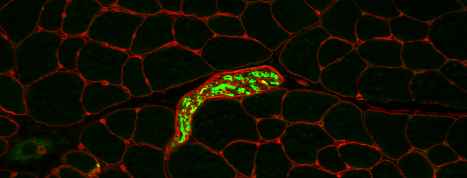Skeletal Muscle Regeneration
Overview
Skeletal muscles rapidly adapt and remodel following an injury. Numerous cell types and cellular events are coordinated during muscle regeneration, often leading to recovery that is indistinguishable from uninjured tissue. I am interested in exploring how the cellular events interact to progress muscle regeneration.
Skeletal Muscle Injury and Regeneration
In addition to exploring injury and inflammation computationally, I was able to follow muscle recovery in a rat TA laceration model. We tracked satellite stem cell (SSC) dynamics in the agent-based model by exploring signalling molecules that influence activation, proliferation, migration, and differentiation. Then the agent-based model predicted the best timing of enhanced macrophage recruitment into the injury. When I pharmacologically manipulated macrophage recruitment in the TA laceration model (via direct injection of M-CSF), we found earlier and elevated markers of regeneration (below).

Nerve and Vascular Remodeling

During muscle regeneration, nerves and blood vessels undergo repair and remodeling. While the extent of regeneration is dependent on the type of injury (as is the case with the muscle fibers), blood vessels and nerves are vital for functional muscle recovery. Dr. George Christ has developed tissue engineered constructs to repair muscle defects following volumetric muscle loss. His lab utilizes porcine bladder scaffolds seeded with muscle progenitor cells to enhance recovery following these injury. One of my projects was to investigate the vascular and neuronal regeneration when using these bioengineered scaffolds to treat a muscle injury. To the right is a capillary with a pericyte and macrophage associated with it, and below is a nerve bundle surrounded by muscle fibers.
